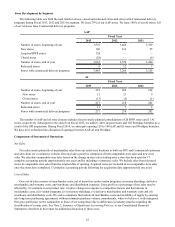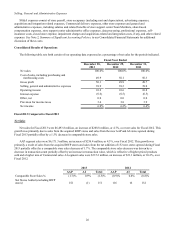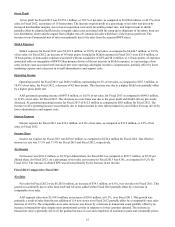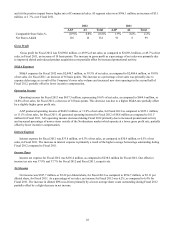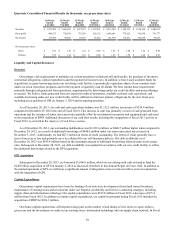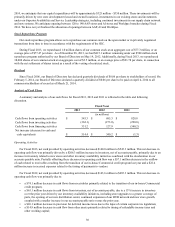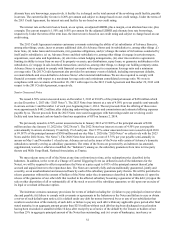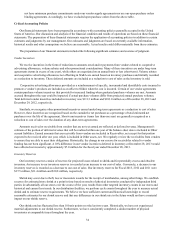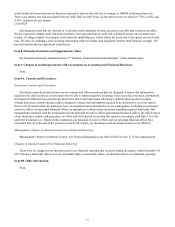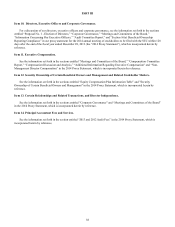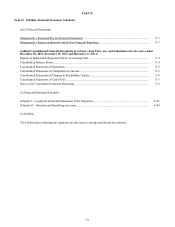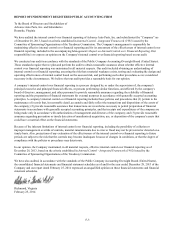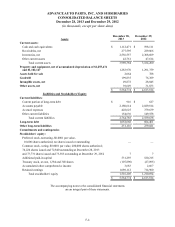Advance Auto Parts 2013 Annual Report Download - page 48
Download and view the complete annual report
Please find page 48 of the 2013 Advance Auto Parts annual report below. You can navigate through the pages in the report by either clicking on the pages listed below, or by using the keyword search tool below to find specific information within the annual report.35
Our inventory consists primarily of parts, batteries, accessories and other products used on vehicles that have reasonably
long shelf lives. Although the risk of obsolescence is minimal, we also consider whether we may have excess inventory based
on our current approach for effectively managing slower moving inventory. We strive to optimize the life cycle of our inventory
to ensure our product availability reflects customer demand. We have return rights with many of our vendors and the majority
of excess inventory is returned to our vendors for full credit. We establish reserves for potentially excess and obsolete
inventories based on (i) current inventory levels, (ii) the historical analysis of product sales and (iii) current market conditions.
In certain situations, we establish reserves when less than full credit is expected from a vendor or when liquidating product will
result in retail prices below recorded costs. In Fiscal 2013, the increase in our inventory reserves was driven primarily by our
continued ramp-up in the sale of imported products and the lack of return privileges with those vendors.
Future changes by vendors in their policies or willingness to accept returns of excess inventory, changes in our inventory
management approach for excess and obsolete inventory or failure by us to effectively manage the life cycle of our inventory
could require us to revise our estimates of required reserves and result in a negative impact on our consolidated statement of
operations. A 10% difference in actual inventory reserves at December 28, 2013 would have affected net income by
approximately $2.3 million for the fiscal year ended December 28, 2013.
Warranty Reserves
We offer limited warranties on certain products that range from 30 days to lifetime warranties; the warranty obligation on
the majority of merchandise sold by us with a manufacturer’s warranty is borne by our vendors. However, we have an
obligation to provide customers free replacement of merchandise or merchandise at a prorated cost if under a warranty and not
covered by the manufacturer. Merchandise sold with warranty coverage by us primarily includes batteries but may also include
other parts such as brakes and shocks. We estimate and record a reserve for future warranty claims at the time of sale based on
the historical return experience of the respective product sold. If claims experience differs from historical levels, revisions in
our estimates may be required, which could have an impact on our consolidated statement of operations. To the extent vendors
provide upfront allowances in lieu of accepting the obligation for warranty claims and the allowance is in excess of the related
warranty expense, the excess is recorded as a reduction to cost of sales.
A 10% change in the warranty reserves at December 28, 2013 would have affected net income by approximately $2.5
million for the fiscal year ended December 28, 2013.
Self-Insurance Reserves
We are self-insured for general and automobile liability, workers’ compensation and the health care claims of our Team
Members, although we maintain stop-loss coverage with third-party insurers to limit our total liability exposure. Our self-
insurance reserves for Fiscal 2013, 2012 and 2011 were $98.5 million, $94.5 million and $98.9 million, respectively.
Historically, our total self-insurance reserves have steadily increased due to our continued growth, including an increase in
stores, Team Members and Commercial delivery vehicles partially offset by favorable claims development in the last two years.
When excluding $4.2 million of reserves from our acquisition of BWP in Fiscal 2013, our self-insurance reserves were
essentially flat with the prior year.
Our self-insurance reserves consist of the estimated exposure for claims filed, claims incurred but not yet reported and
projected future claims, and are established using actuarial methods followed in the insurance industry and our historical claims
experience. Specific factors include, but are not limited to, assumptions about health care costs, the severity of accidents and
the incidence of illness and the average size of claims. Generally, claims for automobile and general liability and workers’
compensation take several years to settle. We classify the portion of our self-insurance reserves that is not expected to be settled
within one year in long-term liabilities.
While we do not expect the amounts ultimately paid to differ significantly from our estimates, our self-insurance reserves
and corresponding SG&A could be affected if future claim experience differs significantly from historical trends and actuarial
assumptions. A 10% change in our self-insurance liabilities at December 28, 2013 would have affected net income by
approximately $6.2 million for the fiscal year ended December 28, 2013.
Goodwill and Intangible Assets
We evaluate goodwill and indefinite-lived intangibles for impairment annually as of the first day of our fiscal fourth
quarter or whenever events or changes in circumstances indicate the carrying value of the goodwill or other intangible asset
may not be recoverable. We complete our impairment evaluation by combining information from our internal valuation
analyses by reporting units, considering other publicly available market information and using an independent valuation firm.


